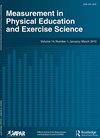儿童肥胖症的患病率取决于采用哪种身体成分和人体测量方法及临界值
IF 1.9
4区 教育学
Q2 EDUCATION & EDUCATIONAL RESEARCH
Measurement in Physical Education and Exercise Science
Pub Date : 2024-02-21
DOI:10.1080/1091367x.2024.2319305
引用次数: 0
摘要
利用2017-2018年全国健康与营养状况调查(加权人口数=35,460,209;8-18岁;52.1%为男性),我们比较了儿童和青少年的肥胖患病率。本文章由计算机程序翻译,如有差异,请以英文原文为准。
The Prevalence of Childhood Obesity Depends on Which Body Composition and Anthropometric Measurement and Cutoff Were Used
Using the 2017–2018 National Health and Nutrition Examination Survey (weighted population size = 35,460,209; 8–18 years old; 52.1% males), we compared the obesity prevalence in children and adolesc...
求助全文
通过发布文献求助,成功后即可免费获取论文全文。
去求助
来源期刊

Measurement in Physical Education and Exercise Science
Medicine-Orthopedics and Sports Medicine
CiteScore
4.20
自引率
33.30%
发文量
24
期刊介绍:
The scope of Measurement in Physical Education and Exercise Science (MPEES) covers original measurement research, special issues, and tutorials within six substantive disciplines of physical education and exercise science. Six of the seven sections of MPEES define the substantive disciplines within the purview of the original research to be published in the journal: Exercise Science, Physical Activity, Physical Education Pedagogy, Psychology, Research Methodology and Statistics, and Sport Management and Administration. The seventh section of MPEES, Tutorial and Teacher’s Toolbox, serves to provide an outlet for review and/or didactic manuscripts to be published in the journal. Special issues provide an avenue for a coherent set of manuscripts (e.g., four to five) to collectively focus in-depth on an important and timely measurement-related issue within the scope of MPEES. The primary aim of MPEES is to publish high-impact manuscripts, most of which will focus on original research, that fit within the scope of the journal.
 求助内容:
求助内容: 应助结果提醒方式:
应助结果提醒方式:


